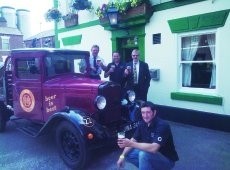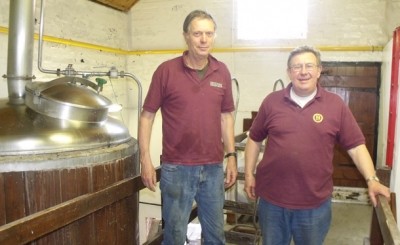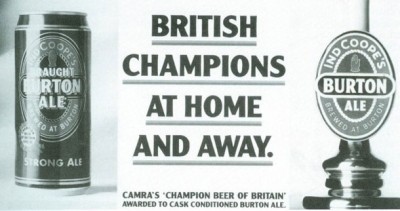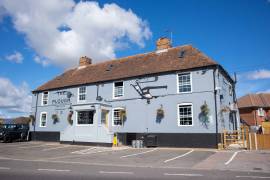Bringing beer back to Burton

I helped launch a Burton Ale in Burton-on-Trent. Nothing remarkable about that, you might think, save for the fact that the beer in question was brewed in Pontypridd, south Wales. The beer, called O-Roger, was produced by the Otley Brewery and the aim was two-fold: to highlight the historic importance of Burton Ale and to show that, at its height, the style was so popular that brewers throughout the country had "a Burton" in their portfolios.
I've been writing a book on the history of beer and brewing in Burton, to be published in October, and the more I delved into the archives the more I understood that Burton Ale deserves greater recognition. For most people, Burton-on-Trent is synonymous with the pale ales and India Pale Ales of the 19th century. But this remarkable small town in the Midlands has been making beer since the 12th century.
Burton's reputation spread as both roads and canals improved in the 18th century. Burton Ale became a popular drink in the fashionable parts of London while the extension of the Trent River to Hull in 1712 enabled brewers to export their ales to Russia and the Baltic States. At its peak, trade with Russia and the Baltic accounted for 70% of Burton's production and encouraged William Bass to sell his carrying company and set up as a brewer in the town.
The Baltic trade collapsed in the 19th century during the long wars with France, when Napoleon blockaded ports in the east. Many Burton brewers went out of business and those that survived — including such famous names as Allsopp, Bass and Worthington — were desperate for new markets.
The mighty East India Company (EIC) encouraged them to export beer to the sub-continent but, in the words of one director of the EIC: "Your Burton Ale, so strong and sweet, will not suit our market."
The result was a rush to develop pale and well-hopped beers for the India trade.
But Burton Ale didn't disappear. The brewers continued to make large amounts of it, but mainly for the domestic market. Well into the 19th century, Bass had six different versions of Burton Ale, ranging from 6% to 10.5% in strength. Bass No 1, still occasionally brewed by the William Worthington Brewery in the National Brewery Centre, is labelled a barley wine, but is in fact the last-remaining example of Bass's Burton Ales.
The style went into deep decline in the 20th century as drinkers switched their allegiance to pale ale and bitter. But in 1976 the style was reborn when Allied Breweries launched Ind Coope Draught Burton Ale. It was a delicious beer but its popularity was virtually snuffed out as a result of major changes in the industry in the 1980s and '90s. Allied split up, the Ind Coope brewery in Burton closed, and Burton Ale moved first to Tetley's in Leeds and then to JW Lees in Manchester. Lees still makes small amounts of the beer and it's almost impossible to find.
So I was delighted when the Otley brothers, Nick, Matthew and Charlie, accepted the challenge to recreate a Burton Ale for my book. We were helped by Geoff Mumford and Bruce Wilkinson at the Burton Bridge Brewery, who had previously worked at Ind Coope. They told us that Draught Burton Ale was based on a once-famous bottled beer, Double Diamond Export.
The Otley brothers didn't have access to the recipe for Double Diamond but we took an educated guess and used pale and amber malts to create the bright copper colour of a true Burton. The hops were English Fuggles and Goldings but Matt Otley, in charge of brewing, added some American Columbus — I knew from my research that the Burton brewers often imported malt and hops from other countries. The beer had an original gravity of 1054, with the aim of reaching 5.2% alcohol, with a massive 50 units of bitterness.
The beer was brewed on 31 March and we had to wait patiently while it matured — as a Burton should — in cask for almost three months. In Burton, courtesy of the Burton Bridge antique truck, the beer was delivered to two of Mumford's and Wilkinson's pubs, the Duke of Devonshire and the Alfred. It is impossible to escape Burton's brewing past: the "Devvie" is opposite the former Bass brewery, now Molson Coors, while the Alfred is across the road from the long-defunct Truman plant.
O-Roger has a massive aroma of hop resins, tart fruit and rich, biscuity malt. The hops, malt and fruit combine in the mouth and the finish is long, complex, dry, bitter and hoppy, but balanced by sweet malt and tart fruit.
I was just concluding that this was one of the most delicious beers I had ever tasted when Nick Otley produced a rabbit from his brewer's hat: a second, "dry-hopped" version of O-Roger, this time with the addition of American Aurora and Galena hops. The beer has a hop character that makes your eyes water.
I hope the amazing Otley brothers will consider including O-Roger, with or without the additional hops, in their regular portfolio. Meanwhile, for my next trick, I shall take some coals to Newcastle...


















